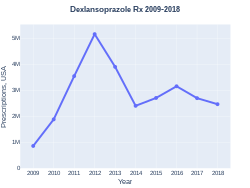Dexlansoprazole
 | |
| Names | |
|---|---|
| Trade names | Kapidex, Dexilant, others |
| |
| Clinical data | |
| Drug class | Proton pump inhibitor |
| Pregnancy category |
|
| Routes of use | By mouth |
| Defined daily dose | 30 mg[1] |
| External links | |
| AHFS/Drugs.com | Monograph |
| MedlinePlus | a695020 |
| Legal | |
| License data |
|
| Legal status |
|
| Pharmacokinetics | |
| Excretion | 50% kidney and 47% in the feces[2] |
| Chemical and physical data | |
| Formula | C16H14F3N3O2S |
| Molar mass | 369.36 g·mol−1 |
| 3D model (JSmol) | |
| |
| |
Dexlansoprazole, sold under the trade name Dexilant among others, is a medication which reduces stomach acid.[3] It is used to treat gastroesophageal reflux disease.[3] Effectiveness is similar to other proton pump inhibitors (PPIs).[4] It is taken by mouth.[3]
Common side effects include diarrhea, abdominal pain, and nausea.[3] Serious side effects may include osteoporosis, low blood magnesium, Clostridium difficile infection, anaphylaxis, and pneumonia.[3] Use in pregnancy and breastfeeding is of unclear safety.[5] It works by blocking H+/K+-ATPase in the parietal cells of the stomach.[3]
Dexlansoprazole was approved for medical use in the United States in 2009.[3] In the United States the wholesale cost for a month is about US$270.[6] In Canada this amount costs about 71.50 CAD in 2016 making it the most expensive PPI available at the time.[4] In 2017, it was the 202nd most commonly prescribed medication in the United States, with more than two million prescriptions.[7][8]
Medical use
Dexlansoprazole is used to heal and maintain healing of erosive esophagitis and to treat heartburn associated with gastroesophageal reflux disease (GERD).[2] It lasts longer than lansoprazole, to which it is chemically related, and needs to be taken less often.[9] There is not good evidence that it works better than other PPIs.[4]
Dosage
The defined daily dose is 30 mg by mouth.[1]
Side effects
The most common side effects (≥2%) reported in clinical trials were diarrhea, abdominal pain, bloating, nausea, upper respiratory tract infection, vomiting, and flatulence.[2]
Mechanism of action
Like lansoprazole, dexlansoprazole permanently binds to the proton pump and blocks it, preventing the formation of gastric acid.[9]
Chemistry
Dexlansoprazole is the (R)-(+)-enantiomer of lansoprazole, which is a racemic mixture of its (R)-(+) and (S)-(−)-enantiomers.[9] The Takeda drug has a dual release pharmaceutical formulation, with two types of granules of dexlansoprazole, each with a coating that dissolves at a different pH level.[9]
Pharmacokinetics
Dexlansoprazole ((R)-(+)-lansoprazole) has the same binding affinity to the proton pump as the (S)-enantiomer, but is associated with a three- to five-fold greater area under the plasma drug concentration time curve (AUC) compared with (S)-lansoprazole.[9] With its dual release pharmaceutical formulation, the first quick release produces a plasma peak concentration about one hour after application, with a second delayed release producing another peak about four hours later.[10][11]
History
Dexlansoprazole was approved by the U.S. Food and Drug Administration (FDA) in 2009, and was approved in Canada in 2010 and in Mexico in 2011.[9]Since Kapidex was approved in 2009, there have been reports of dispensing errors because of confusion with the drugs Casodex (bicalutamide) and Kadian (morphine), which have very different uses from Kapidex and from each other. In 2010, the FDA approved a name change for Kapidex to avoid confusion with the two other medications and Takeda began marketing it under the new name Dexilant.[12] It is also available in Bangladesh as Dexilend by Ziska Pharmaceuticals. [13]
Society and culture
Cost
In the United States the wholesale cost for a month is about US$270.[6] In Canada this amount costs about 71.50 CAD in 2016 making it the most expensive PPI available at the time.[4] In 2017, it was the 202nd most commonly prescribed medication in the United States, with more than two million prescriptions.[7][8]
-
Dexlansoprazole costs (US)
-
Dexlansoprazole prescriptions (US)
References
- ↑ 1.0 1.1 "WHOCC - ATC/DDD Index". www.whocc.no. Archived from the original on 16 April 2021. Retrieved 7 September 2020.
- ↑ 2.0 2.1 2.2 Product Information: DEXILANT® delayed release oral capsules, dexlansoprazole delayed release oral capsules Archived 2017-02-28 at the Wayback Machine. Takeda Pharmaceuticals, Inc., Deerfield, IL, 2010. Revised: September 2012
- ↑ 3.0 3.1 3.2 3.3 3.4 3.5 3.6 "Dexlansoprazole Monograph for Professionals". Drugs.com. American Society of Health-System Pharmacists. Archived from the original on 28 April 2019. Retrieved 3 March 2019.
- ↑ 4.0 4.1 4.2 4.3 "[99] Comparative effectiveness of proton pump inhibitors | Therapeutics Initiative". 28 June 2016. Archived from the original on 30 October 2020. Retrieved 14 July 2016.
- ↑ "Dexlansoprazole Use During Pregnancy". Drugs.com. Archived from the original on 20 January 2021. Retrieved 3 March 2019.
- ↑ 6.0 6.1 "NADAC as of 2019-02-27". Centers for Medicare and Medicaid Services. Archived from the original on 2019-03-06. Retrieved 3 March 2019.
- ↑ 7.0 7.1 "The Top 300 of 2020". ClinCalc. Archived from the original on 12 February 2021. Retrieved 11 April 2020.
- ↑ 8.0 8.1 "Dexlansoprazole - Drug Usage Statistics". ClinCalc. Archived from the original on 28 February 2020. Retrieved 11 April 2020.
- ↑ 9.0 9.1 9.2 9.3 9.4 9.5 Behm BW, Peura DA (August 2011). "Dexlansoprazole MR for the management of gastroesophageal reflux disease". Expert Review of Gastroenterology & Hepatology. 5 (4): 439–45. doi:10.1586/egh.11.37. PMID 21780890.
- ↑ "FDA Approves KAPIDEX (dexlansoprazole) delayed release capsules for the Treatment of GERD". Archived from the original on 2012-05-10. Retrieved 2010-04-02.
- ↑ Metz DC, Vakily M, Dixit T, Mulford D (May 2009). "Review article: dual delayed release formulation of dexlansoprazole MR, a novel approach to overcome the limitations of conventional single release proton pump inhibitor therapy". Alimentary Pharmacology & Therapeutics. 29 (9): 928–37. doi:10.1111/j.1365-2036.2009.03984.x. PMID 19298580.
- ↑ "KAPIDEX (dexlansoprazole) Renamed DEXILANT in U.S. to Avoid Name Confusion". Takeda. 4 March 2010. Archived from the original on 12 March 2010. Retrieved 7 April 2010.
- ↑ "Dexilend | Capsule (Delayed Release) | 30 mg | Ziska Pharmaceuticals Ltd. | Indications, Pharmacology, Dosage, Side Effects & other Generic Info | Medex". medex.com.bd. Archived from the original on 29 August 2021. Retrieved 25 October 2020.
External links
| External sites: | |
|---|---|
| Identifiers: |
|
- Pages using duplicate arguments in template calls
- Webarchive template wayback links
- Articles with changed InChI identifier
- Chemical articles with unknown parameter in Infobox drug
- Chemical articles without CAS registry number
- Articles without EBI source
- Chemical pages without ChemSpiderID
- Chemical pages without DrugBank identifier
- Articles without KEGG source
- Articles without UNII source
- Drugs missing an ATC code
- Drugboxes which contain changes to verified fields
- Drugboxes which contain changes to watched fields
- Articles with changed ChemSpider identifier
- Articles with changed EBI identifier
- Proton pump inhibitors
- Benzimidazoles
- Sulfoxides
- Pyridines
- Enantiopure drugs
- Aromatic ethers
- Trifluoromethyl compounds
- Takeda Pharmaceutical Company brands
- RTT

